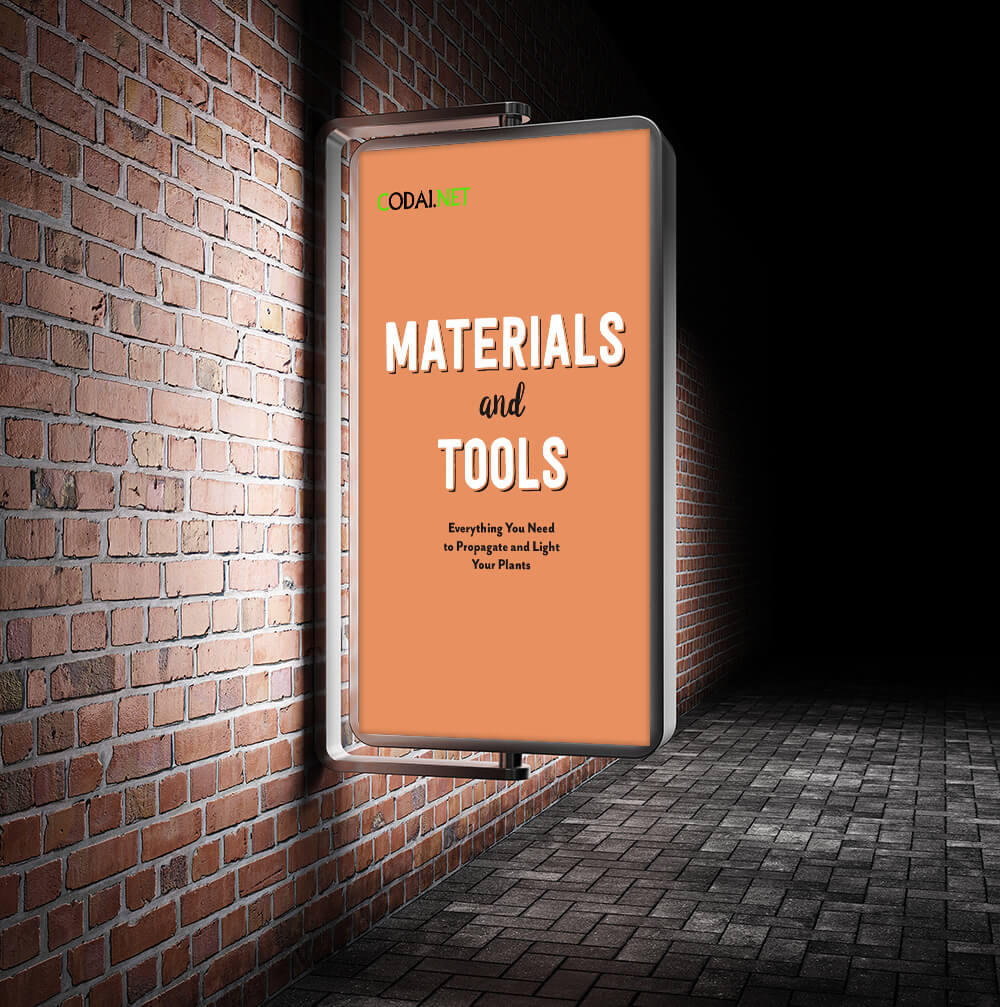Ebook Việt Hoá] Plant parenting: Easy ways to make more houseplants vegetables and flowers - LESLIE F. HALLECK
[Ebook Việt Hoá] Plant parenting – LESLIE F. HALLECK (Nhân giống cây) – GROW LIGHTING 101 (Hệ thống ánh sáng trồng cây 101)
- Nguồn: [Ebook Việt Hoá] Plant parenting: Easy ways to make more houseplants, vegetables, and flowers – LESLIE F. HALLECK (Nhân giống cây: Những cách dễ nhất để nhân giống cây cảnh trong nhà, rau và hoa)
- Biên tập: Dũng Cá Xinh (Tháng 08/20201)
- Dịch: Huyền Nguyễn
English
If you’re growing in a space with little to no natural light, then artificial grow lighting is mandatory for plant propagation and growth. Seedlings, in particular, will almost always require grow lights. The time of year you propagate indoors will also influence your lighting needs. If you start your seeds or take cuttings indoors during winter months, you’ll find that the lack of light and briefer duration of light can really slow things down. Short winter day lengths, a lower angle of the sun, and cloudy days all reduce the amount of natural light in your home available to plants.
Seedlings require intense amounts of light for specific durations; most windowsills simply are not bright enough, for a long-enough duration, for healthy seedlings. Conversely, vegetative cuttings you are rooting in soil, water, or other growing media don’t require a lot of bright light—they only need the amount of light they’d receive in a bright windowsill. Cuttings can benefit from 24 hours of lower-intensity light until they root. So, the rule of thumb is that you need grow lights for seedlings and bright ambient light for cuttings.
DURATION AND DISTANCE OF LIGHT
Once a seedling shoot emerges from beneath the soil, both the amount of bright light and the duration of light are important. After sprouting, seedlings will need 14 to 16 hours of bright light to grow strong and sturdy. This is not because all seedlings are “long-day plants” (which is a reference to a photoperiodic requirement) as you might find them erroneously described in any number of online resources. It is simply because they need a lot of light and it takes that many hours of bright light to deliver what seedlings need.
Most indoor rooms, even those with large windows or plenty of diffused light, are not bright enough for baby seedlings. If your seedlings are elongating and stretching, they aren’t getting enough light. Stretched seedlings will frequently topple and fail. If an overstretched seedling does survive long enough for you to transplant it into a larger container, the plant often has a tough time thriving and may not produce the desired results or harvest.
Vegetative cuttings, on the other hand, can be grown under continuous, less intense light until they develop roots. Bright light levels can burn your cuttings or cause leaves to yellow and drop. Typically, ambient light from a bright window is strong enough for unrooted cuttings and those that have not yet put on any new growth. Indirect light from grow lamps is also ideal. You can expose cuttings to 24 hours of light to speed up the rooting process. If you aren’t using grow lamps and your cuttings are receiving only shorter durations of light from a bright windowsill, that’s okay. Just know that it will take longer for the cuttings to root than if they received 24 hours of light. Once the cuttings have rooted and start pushing out new growth, you can place them under brighter grow lighting for that type of plant for the correct duration.
The closer your grow lamp is to your plants, the greater amount of light (and heat) will be delivered. As you increase the distance between the lamp and plant, less light (and heat) will be delivered. As stated several times already (I really mean it) seedlings need a lot of light. The light source must be very close to your seedlings as they germinate, as near as 3 to 4 inches from the seeds as they emerge from the soil. If the light is further away, less light will be delivered, and young sprouts can quickly stretch beyond their ability to remain intact.
Ratcheted cords or chains that allow you to move light fixtures up and down will enable you to place your lamps very close to seedlings as they are just emerging, then lift the light source higher as they grow. If you are using a fixture with adjustable shelves, you can create short and tall sections. Start the seeds on a short shelf that places them closer to the light, then move them to taller shelf sections as they grow—leaving more space between the plants and the light. Another method is to prop up your seed trays with inverted plant trays or other containers to set them closer to the light as they are germinating; then remove the props once seedlings are larger and need to be set further away from the grow lamps.
As vegetative cuttings need lower intensity light until they root, you should place grow lighting at least 2 feet above your cuttings—higher is better. Indirect light from a grow light in the middle of the room or nearby is usually adequate. If you place grow lamps too close to your cuttings, the higher amount of light delivered can damage them. Once your cuttings are rooted and begin growing new leaves, then you can intensify the light levels and place them closer to the light source.
If you are rooting vegetative cuttings, but you don’t have the space or ability to move your lights up and down, you can start by removing two or three of the LED or fluorescent lamps from the grow light fixture to reduce light levels. As cuttings root and grow, you can reinsert the removed lamps.
Supplemental lighting may need to be turned on and off at times that aren’t convenient for your human schedule. It is very easy to forget turning plant lights on and off at the right times for your plants. The best solution is to use simple or programmable timers. You can use the same simple timers you use to automatically turn on and off your house lamp while you’re away on vacation or you can purchase digital timers that allow you to program a specific schedule.
TYPES OF LIGHT
Without getting too deep into light science, it’s good to know that the different spectrums (colors) of light will influence different types of plant growth and development. To speak very generally, blue (cool) light favors vegetative growth, while red (warm) light favors flowering. Full spectrum light on the cool side of the light spectrum is best for starting seeds and cuttings. Look for grow lamps labeled specifically for leafy vegetative growth; lamps in the 5000 to 7000K measurement range are appropriate. While your plants will still root and grow with more red light, or a warmer spectrum of light, you’ll find that too much red light will cause them to elongate and stretch—not good for seedlings.
Full spectrum grow lamps will emit all colors of light in varying amounts, providing a mostly white or slightly tinted (warm or cool) color of light. Dual- or multi-band LEDs will generate a pink- or purple-colored light because they blend only red and blue light together, or sometimes red, blue, and one or two other spectrums of light. As red and blue light is used most efficiently by plants for photosynthesis, you can use dual-band LEDs that only mix the red and blue spectrum but be prepared for your space to be awash in pink light.
GROW LAMPS
There are many different types of grow lamps to choose from and picking the right one can be a daunting task. Some lamps generate more light or more heat than others. Luckily for propagation purposes, you can rely on many of the smaller, less expensive types of grow lamps to meet your needs.
Skip incandescent bulbs. They don’t generate enough light for your plants and they generate too much heat.
Cool spectrum high-output fluorescent lamps (HO T5 fluorescent lamps), CFLs (compact fluorescent lamps), and LEDs are typically the easiest and best options for starting young seedlings and rooting cuttings, as they generate relatively low levels of heat and can be placed close to your tiny plants. HO T5 fluorescents remain an efficient and inexpensive grow lighting option for the home gardener. LEDs can cost a bit more but offer the added benefit of lower heat output and longer lamp life. LED grow lamp technology is advancing quickly and there are many new options available.
If you are using HO T5 florescent lamps or LED bars for starting seeds, you’ll typically use a fixture that holds two to four tubes or bars (lamps), depend- ing on how many seed or cutting trays you have. Your goal is to deliver even amounts of light to the entire seed tray—even the edges. Small spotlight grow lamps (CFLs or LEDs) won’t provide enough light for your entire tray of seedlings. If you are using an LED panel, then it needs to be large enough so light emitted reaches all your seedlings or cuttings evenly.
If you want to use a smaller light fixture and diffuse light over a larger area, you’ll need to use reflective wall covering or start your seeds and cuttings inside small grow tents.
I find that seed-starting kits that only come with one small HO T5 fluorescent or LED lamp often don’t provide enough light, causing seedlings to stretch unless they are also next to a bright window and receive a good amount of natural light. However, these lower light setups are perfect for rooting vegetative cuttings.
When I am growing seedlings, I use HO T5 fluorescent or LED fixtures that hold up to four lamps. These setups will provide the intense light that young seedlings need. If you already have fluorescent fixtures and you want to use LED lamps, you can insert LED bars that are retrofitted for fluorescent fixtures, which can emit less heat.
CFL spot lamps are available in small sizes (60 W) that can be inserted into standard light fixtures and larger sizes (250 W) that can be inserted into a grow lamp hood with a light reflector. The small bulbs are good options for small groups of seedlings, vegetative cuttings, or an individual houseplant—you can use the larger lamps with reflectors for larger groups of plants or edible crops.
If you really want to dig deeper into light science, how to measure and manipulate light, and all the specific types of grow lamps, be sure to pick up my book Gardening Under Lights: A Complete Guide for Indoor Growers. It will also help you learn how to grow food and ornamental plants indoors year-round, by using grow lighting.
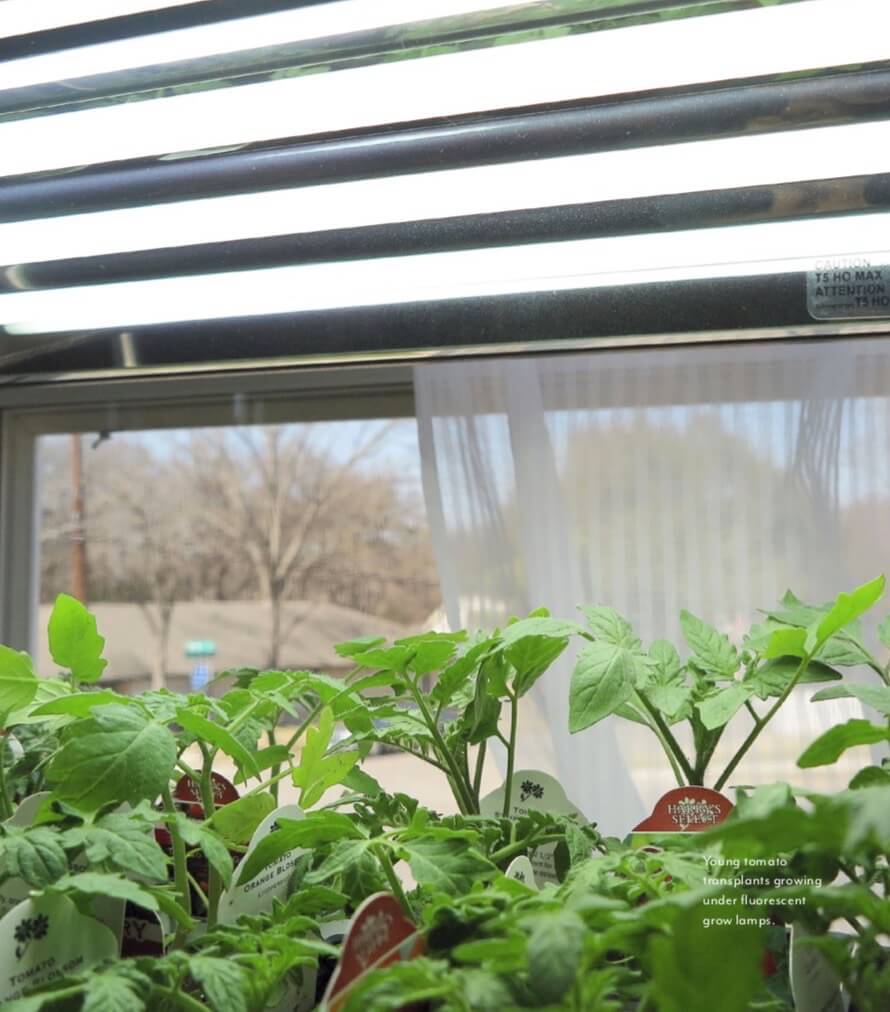
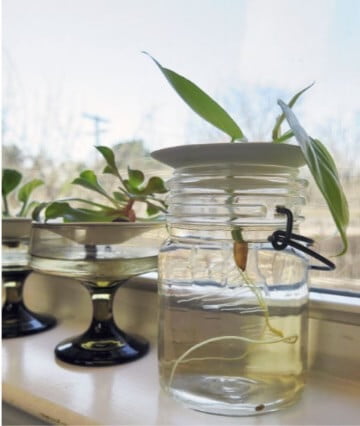
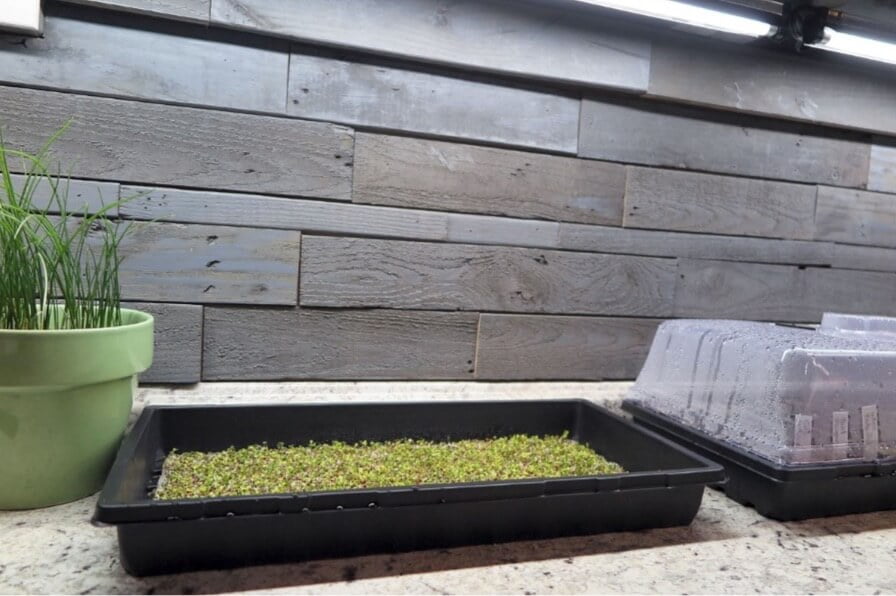
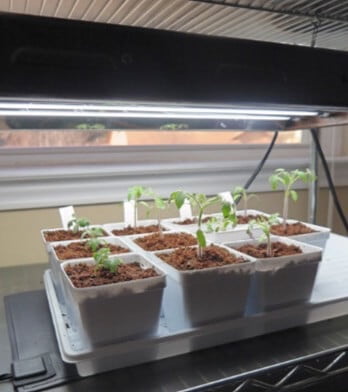
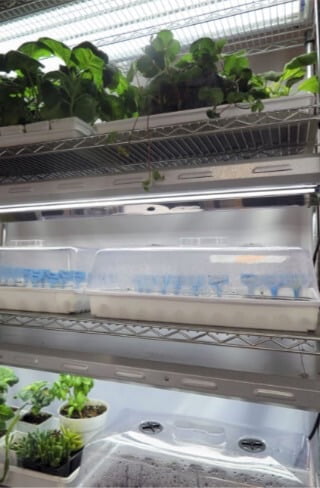
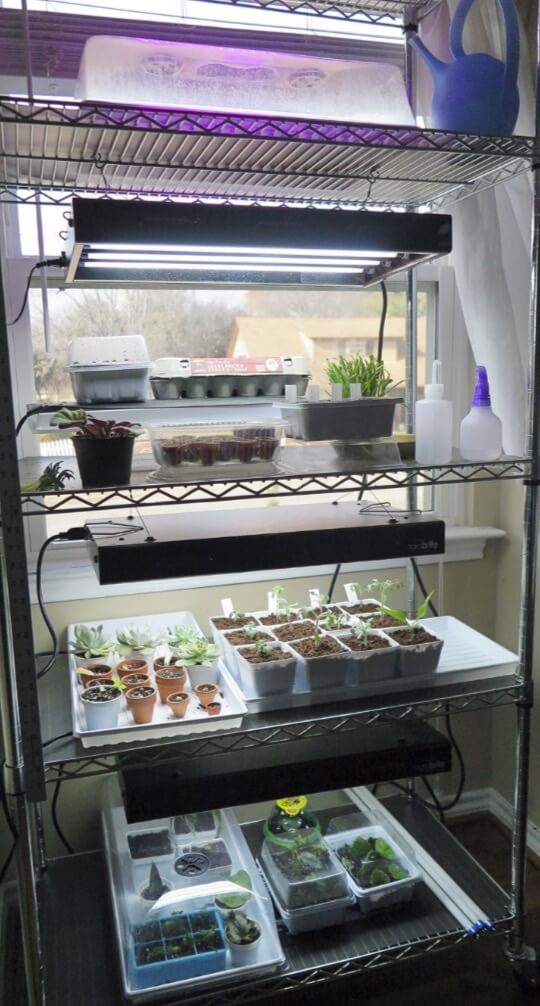
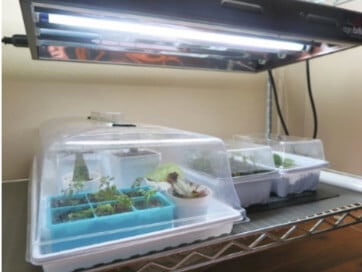
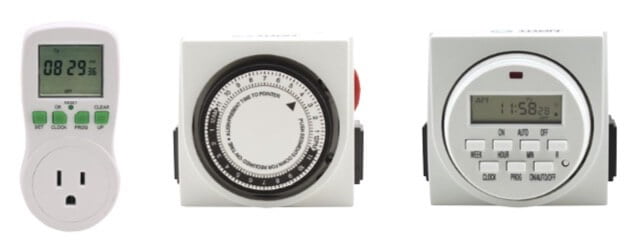
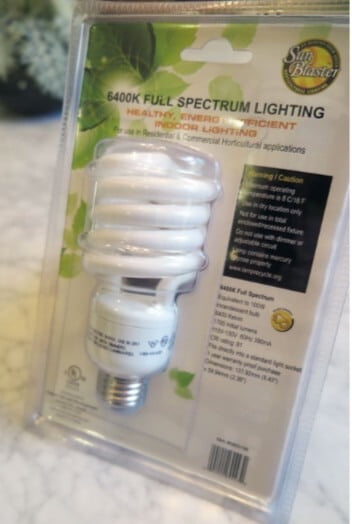
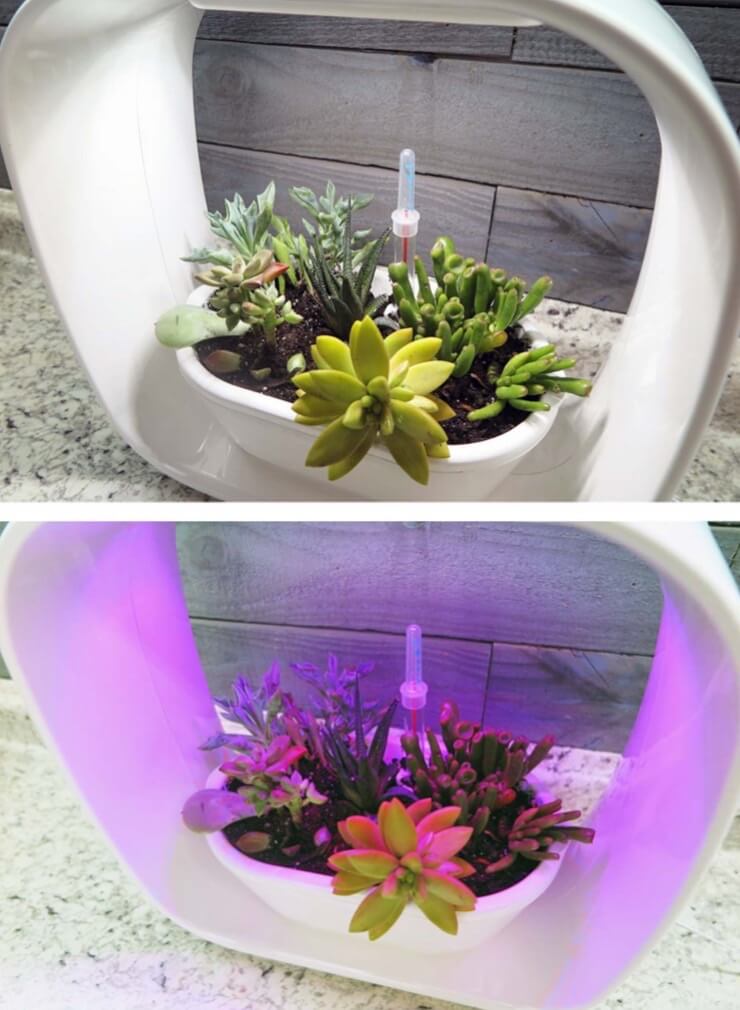
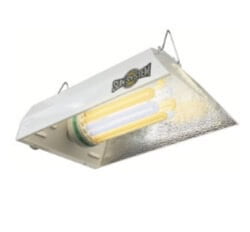
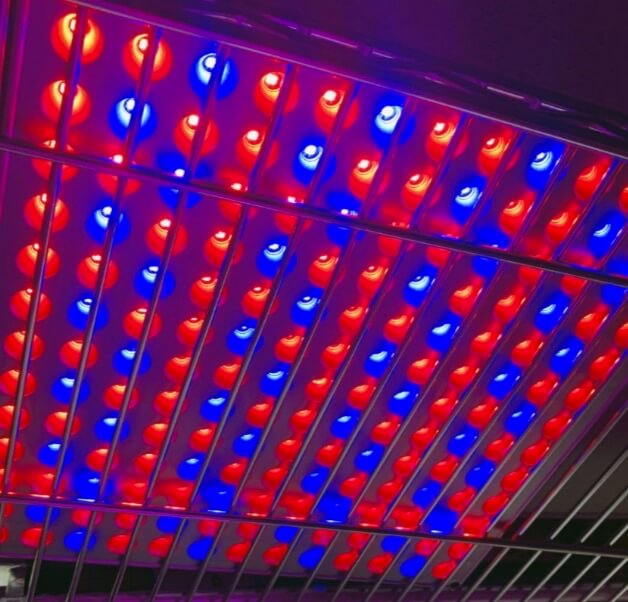
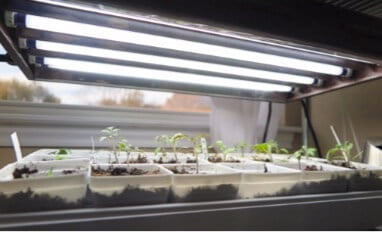
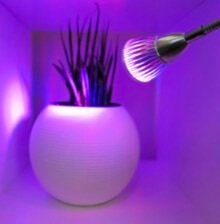
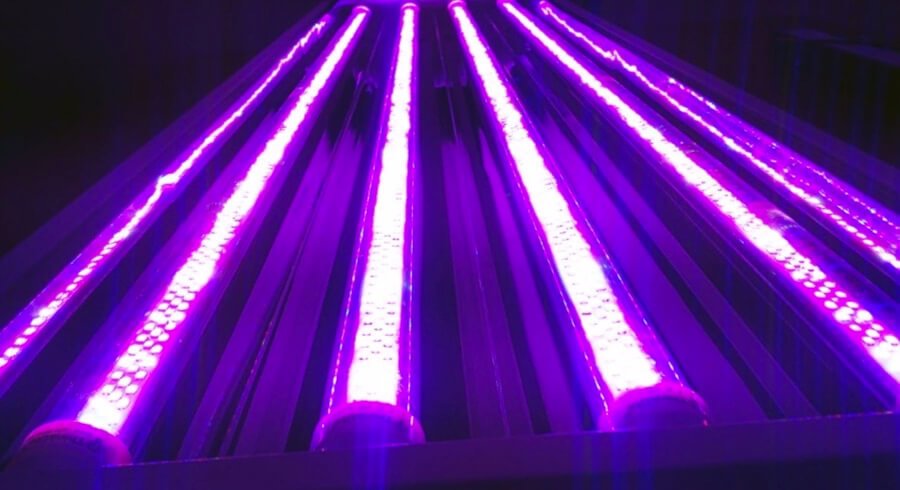
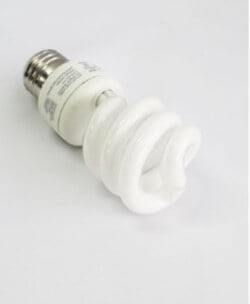
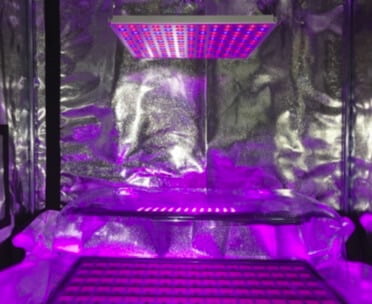
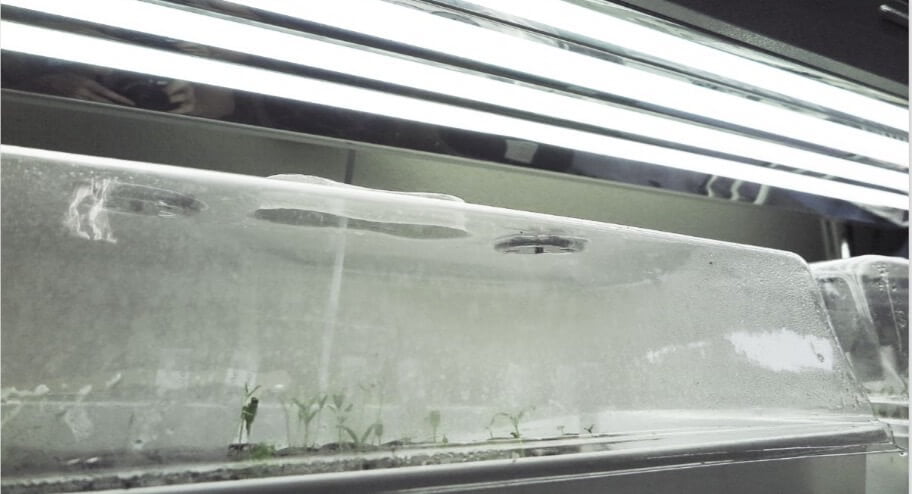
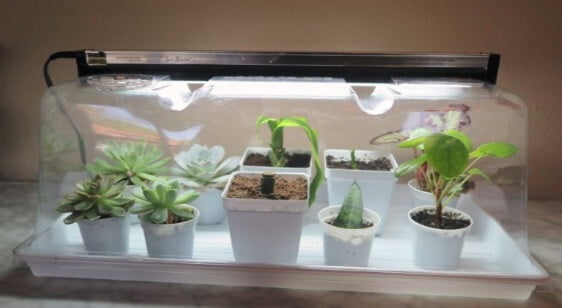
Tiếng Việt
Nếu bạn đang trồng cây trong một không gian có ít hoặc không có ánh sáng tự nhiên, thì ánh sáng nhân tạo cho cây trồng là bắt buộc phải có trong quá trình nhân giống và phát triển của cây. Đặc biệt, cây con hầu như luôn luôn yêu cầu đèn trồng cây. Khoảng thời gian bạn trồng trong nhà cũng sẽ ảnh hưởng đến nhu cầu chiếu sáng của cây. Nếu bạn bắt đầu gieo hạt hoặc giâm cành trong nhà vào những tháng mùa đông, bạn sẽ thấy rằng việc thiếu ánh sáng và thời gian chiếu sáng ngắn có thể làm quá trình nhân giống chậm lại. Mùa đông ngày ngắn, góc mặt trời thấp hơn và những ngày nhiều mây đều làm giảm lượng ánh sáng tự nhiên cung cấp cho cây trồng trong nhà.
Cây con cần lượng ánh sáng mạnh trong khoảng thời gian cụ thể, hầu hết các bệ cửa sổ không đủ sáng, hoặc không có ánh sáng trong một khoảng thời gian đủ dài để cây con phát triển khỏe mạnh. Ngược lại, cành giâm sinh dưỡng mà bạn đang giâm trong đất, nước hoặc các chất trồng khác không cần nhiều ánh sáng, chúng chỉ cần lượng ánh sáng trong bệ cửa sổ sáng sủa. Cây giâm cành có thể hưởng lợi từ ánh sáng cường độ thấp hơn 24 giờ cho đến khi chúng ra rễ. Vì vậy, nguyên tắc chung là bạn cần có đèn chiếu sáng cho cây con và ánh sáng cho cây giâm cành.
LƯỢNG ÁNH SÁNG VÀ THỜI GIAN CHIẾU SÁNG
Khi chồi cây con mọc lên từ dưới đất, cả lượng ánh sáng và thời gian chiếu sáng đều quan trọng. Sau khi nảy mầm, cây con sẽ cần từ 14 đến 16 giờ ánh sáng để phát triển mạnh mẽ và cứng cáp. Điều này không phải vì tất cả các cây con đều là “cây dài ngày” (nghĩa là yêu cầu quang chu kỳ) vì bạn có thể thấy thông tin này được mô tả sai trong bất kỳ nguồn trực tuyến nào. Đơn giản là vì cây con cần nhiều ánh sáng và cần nhiều giờ sáng để cung cấp những gì chúng cần.
Hầu hết các phòng trong nhà, ngay cả những phòng có cửa sổ lớn hoặc nhiều ánh sáng khuếch tán, đều không đủ sáng cho cây con. Nếu cây con của bạn đang phát triển dài ra, chúng đang không nhận đủ ánh sáng. Cây con mọc kéo dài sẽ thường xuyên bị đổ và hỏng. Nếu một cây con phát triển quá dài, có thể nó sẽ không tồn tại đến khi bạn có thể trồng nó vào một chậu lớn hơn, những cây như vậy thường rất khó phát triển và có thể không cho kết quả hoặc thu hoạch như mong muốn.
Mặt khác, các cành giâm sinh dưỡng có thể được trồng dưới ánh sáng liên tục, với cường độ ánh sáng thấp hơn cho đến khi chúng phát triển rễ. Mức độ ánh sáng chói có thể làm cháy cành giâm hoặc làm cho lá vàng và rụng. Thông thường, ánh sáng xung quanh từ cửa sổ sáng đủ mạnh cho các cành giâm chưa ra rễ và những cành chưa mọc mầm mới. Ánh sáng gián tiếp từ đèn trồng cũng lý tưởng. Bạn có thể phơi hom dưới ánh sáng 24 giờ để đẩy nhanh quá trình ra rễ. Nếu bạn không sử dụng đèn trồng và cành giâm chỉ nhận được ánh sáng trong khoảng thời gian ngắn từ bệ cửa sổ sáng, điều đó cũng không sao.Tuy nhiên, bạn hãy lưu ý rằng sẽ mất nhiều thời gian hơn để cành giâm ra rễ so với khi chúng được chiếu sáng 24 giờ. Khi cành giâm đã bén rễ và bắt đầu mọc chồi mới, bạn có thể đặt chúng dưới ánh sáng đèn trồng sáng hơn trong một khoảng thời gian nhất định.
Đèn trồng cây càng gần cây trồng, thì lượng ánh sáng và nhiệt lượng được truyền ra càng lớn. Khi bạn tăng khoảng cách giữa đèn và cây, lượng ánh sáng và nhiệt sẽ được truyền đi ít hơn. Như tôi đã nói ở trên, cây con cần rất nhiều ánh sáng. Nguồn sáng phải rất gần với cây con khi chúng nảy mầm, gần hạt giống từ 3 đến 4 inch khi chúng nhú lên khỏi đất. Nếu ánh sáng ở xa hơn, ánh sáng sẽ được phân phối ít hơn và mầm non có thể nhanh chóng phát triển dài ra.
Dây hoặc dây xích có đinh tán cho phép bạn di chuyển các thiết bị chiếu sáng lên và xuống, giúp bạn đặt đèn rất gần với cây con khi chúng mới mọc, sau đó nâng nguồn sáng lên cao hơn khi cây lớn lên. Nếu bạn đang sử dụng vật cố định với các giá có thể điều chỉnh, bạn có thể tạo các phần ngắn và cao. Bắt đầu gieo hạt trên một giá thể ngắn đặt chúng gần ánh sáng hơn, sau đó chuyển chúng lên các ngăn kệ cao hơn khi chúng lớn lên, tạo nhiều không gian hơn giữa cây và ánh sáng. Một phương pháp khác là nâng khay hạt giống bằng khay trồng cây ngược hoặc các vật chứa khác để đặt chúng gần ánh sáng hơn khi đang nảy mầm, sau đó loại bỏ các dụng cụ nâng khi cây con lớn hơn và cần đặt xa đèn trồng.
Vì cành giâm sinh dưỡng cần ánh sáng cường độ thấp hơn cho đến khi chúng mọc rễ, bạn nên đặt đèn chiếu sáng cao hơn cành giâm ít nhất 2 feet, càng cao càng tốt. Ánh sáng gián tiếp từ đèn trồng ở giữa phòng hoặc gần đó cũng đủ để cành giâm phát triển. Nếu bạn đặt đèn trồng quá gần cành giâm, lượng ánh sáng truyền vào cao hơn có thể làm hỏng cành. Khi cành giâm đã bén rễ và bắt đầu mọc lá mới, bạn có thể tăng cường độ ánh sáng và đặt chúng gần nguồn sáng hơn.
Nếu bạn đang giâm cành sinh dưỡng, nhưng bạn không có không gian hoặc khả năng để di chuyển đèn lên xuống, bạn có thể bắt đầu bằng cách loại bỏ hai hoặc ba đèn LED hoặc đèn huỳnh quang khỏi thiết bị cố định ánh sáng để giảm mức độ ánh sáng. Khi cành giâm mọc rễ và phát triển, bạn có thể lắp lại các đèn đã loại bỏ.
Ánh sáng bổ sung có thể cần được bật và tắt vào những thời điểm không thuận tiện cho bạn, bạn rất dễ quên bật và tắt đèn trồng cây vào những thời điểm thích hợp cho cây trồng của mình. Giải pháp tốt nhất là sử dụng bộ hẹn giờ đơn giản hoặc có thể sử dụng bộ hẹn giờ lập trình sẵn. Bạn có thể sử dụng cùng một bộ hẹn giờ đơn giản để tự động bật và tắt đèn nhà khi đi nghỉ hoặc bạn có thể mua bộ hẹn giờ kỹ thuật số cho phép bạn lập một lịch trình cụ thể.
CÁC LOẠI ÁNH SÁNG
Không cần tìm hiểu quá sâu về khoa học ánh sáng, bạn nên biết rằng các quang phổ (màu sắc) khác nhau của ánh sáng sẽ ảnh hưởng đến các loại hình sinh trưởng và phát triển của thực vật. Nói một cách tổng quát, ánh sáng xanh lam (mát mẻ) hỗ trợ sự phát triển của sinh vật, trong khi ánh sáng đỏ (ấm áp) hỗ trợ quá trình ra hoa. Ánh sáng phổ đầy đủ ở phía mát của quang phổ ánh sáng là tốt nhất để bắt đầu gieo hạt và giâm cành. Tìm các loại đèn trồng được dán nhãn là hỗ trợ phát triển cây lá, đèn trong dải đo 5000 đến 7000K là thích hợp. Mặc dù cây của bạn vẫn mọc rễ và phát triển với nhiều ánh sáng đỏ hơn hoặc phổ ánh sáng ấm hơn, nhưng bạn sẽ thấy rằng quá nhiều ánh sáng đỏ sẽ khiến cây phát triển dài ra, điều này không tốt cho cây con.
Đèn trồng cây quang phổ đầy đủ sẽ phát ra tất cả các màu ánh sáng với số lượng khác nhau, cung cấp ánh sáng chủ yếu là màu trắng hoặc hơi pha chút màu ấm hoặc lạnh. Đèn LED kép hoặc nhiều dải sẽ tạo ra ánh sáng có màu hồng hoặc tím vì chúng chỉ pha trộn ánh sáng đỏ và xanh lam với nhau, hoặc đôi khi là màu đỏ, xanh lam và một hoặc hai phổ ánh sáng khác. Vì ánh sáng đỏ và xanh lam giúp thực vật quang hợp hiệu quả nhất, bạn có thể sử dụng đèn LED băng tần kép chỉ kết hợp quang phổ màu đỏ và xanh lam nhưng hãy chuẩn bị đón ánh sáng hồng ngập tràn không gian của bạn.
ĐÈN TRỒNG CÂY
Có nhiều loại đèn trồng khác nhau để lựa chọn và việc chọn được loại phù hợp có thể là một nhiệm vụ khó khăn. Một số loại đèn tạo ra nhiều ánh sáng hơn hoặc nhiều nhiệt hơn những loại đèn khác. Để nhân giống, bạn có thể sử dụng nhiều loại đèn trồng nhỏ, ít tốn kém hơn.
Không sử dụng bóng đèn sợi đốt bởi loại đèn này không tạo ra đủ ánh sáng cho cây và chúng tạo ra quá nhiều nhiệt.
Đèn huỳnh quang công suất cao phổ mát (đèn huỳnh quang HO T5), CFL (đèn huỳnh quang compact) và đèn LED thường là những lựa chọn dễ nhất và tốt nhất để bắt đầu ươm cây con và giâm cành vì chúng tạo ra mức nhiệt tương đối thấp và có thể được đặt gần với những cây nhỏ. Đèn huỳnh quang HO T5 vẫn là một lựa chọn chiếu sáng hiệu quả và rẻ đối với người làm vườn tại nhà. Đèn LED có thể đắt hơn một chút nhưng mang lại lợi ích bổ sung là tỏa nhiệt thấp hơn và tuổi thọ đèn lâu hơn. Công nghệ đèn LED trồng cây đang phát triển nhanh chóng và cung cấp nhiều lựa chọn mới.
Nếu bạn đang sử dụng đèn huỳnh quang HO T5 hoặc thanh LED để bắt đầu gieo hạt, thông thường bạn sẽ sử dụng một bộ cố định có chứa hai đến bốn ống hoặc thanh (đèn), tùy thuộc vào số lượng khay hạt giống hoặc khay cành giâm bạn có. Mục tiêu là cung cấp lượng ánh sáng đồng đều cho toàn bộ khay hạt giống bao gồm cả các cạnh. Đèn trồng cây nhỏ (CFL hoặc đèn LED) sẽ không cung cấp đủ ánh sáng cho toàn bộ khay cây con. Nếu bạn đang sử dụng bảng điều khiển LED, thì nó cần phải đủ lớn để ánh sáng phát ra có thể tiếp cận đồng đều tất cả cây con hoặc cành giâm.
Nếu bạn muốn sử dụng thiết bị cố định ánh sáng nhỏ hơn và khuếch tán ánh sáng trên một khu vực lớn hơn, bạn sẽ cần sử dụng lớp phủ tường phản chiếu hoặc bắt đầu gieo hạt và giâm cành bên trong các lều trồng nhỏ.
Tôi nhận thấy rằng các bộ dụng cụ ươm hạt chỉ đi kèm với một bóng đèn LED hoặc huỳnh quang HO T5 nhỏ thường không cung cấp đủ ánh sáng, khiến cây con mọc dài ra trừ khi chúng ở cạnh cửa sổ sáng và nhận được lượng ánh sáng tự nhiên tốt. Tuy nhiên, những thiết bị cung cấp ánh sáng thấp hơn này là dụng cụ hoàn hảo để giúp cành giâm cành sinh dưỡng ra rễ.
Khi trồng cây con, tôi sử dụng đèn huỳnh quang hoặc đèn LED HO T5 có thể chứa tối đa bốn bóng đèn. Loại đèn này sẽ cung cấp ánh sáng cường độ cao mà cây con cần. Nếu bạn đã có đèn huỳnh quang và muốn sử dụng đèn LED, bạn có thể lắp các thanh LED được trang bị thêm cho đèn huỳnh quang để chúng tỏa ra ít nhiệt hơn.
Đèn chiếu điểm CFL có sẵn với kích thước nhỏ (60 W) có thể được lắp vào thiết bị chiếu sáng tiêu chuẩn và kích thước lớn hơn (250 W) có thể được lắp vào mũ trùm đèn trồng với bộ phản xạ ánh sáng. Bóng đèn nhỏ là lựa chọn tốt cho các nhóm cây con nhỏ, hom sinh dưỡng hoặc một cây trồng riêng lẻ, bạn có thể sử dụng đèn lớn hơn có gương phản xạ cho các nhóm cây lớn hơn hoặc cây ăn được.
Nếu bạn thực sự muốn tìm hiểu sâu hơn về khoa học ánh sáng, cách đo và điều chỉnh ánh sáng cũng như tất cả các loại đèn trồng cụ thể, hãy nhớ chọn cuốn sách Làm vườn dưới ánh sáng: Hướng dẫn hoàn chỉnh cho người trồng cây trong nhà (A Complete Guide for Indoor Growers). Cuốn sách này cũng sẽ giúp bạn học cách trồng thực phẩm và cây cảnh trong nhà quanh năm bằng cách sử dụng ánh sáng đèn trồng.



















